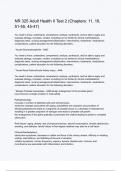NR 325 Adult Health II Test 2 (Chapters: 11, 16,
51-55, 45-47)
You need to know, understand, comprehend, analyze, synthesize, and be able to apply and
evaluate etiology, concepts, context, including but not limited to clinical manifestations,
diagnostic tests, nursing management/collaborative, interventions, treatments, medications,
complications, patient education for the following disorders::
* Acute Glomerulonephritis - ANS-
You need to know, understand, comprehend, analyze, synthesize, and be able to apply and
evaluate etiology, concepts, context, including but not limited to clinical manifestations,
diagnostic tests, nursing management/collaborative, interventions, treatments, medications,
complications, patient education for the following disorders::
* Acute Renal Failure/Acute Kidney Injury - ANS-
You need to know, understand, comprehend, analyze, synthesize, and be able to apply and
evaluate etiology, concepts, context, including but not limited to clinical manifestations,
diagnostic tests, nursing management/collaborative, interventions, treatments, medications,
complications, patient education for the following disorders::
* Benign Prostate Hyperplasia - ANS-benign enlargement of the prostate gland
most common urologic problem in male adults
Pathophysiology:
increase in number of epithelial cells and stromal tissue
endocrine changes associated with aging. possibilities are excessive accumulation of
dihydroxytestosterone leads to overgrowth of prostate tissue or a decrease in testosterone
resulting in a greater proportion of estrogen and leads to prostate cell growth
the enlargement of the gland gradually compresses the urethra leading to partial or complete
obstruction
Risk factors: aging, obesity, lack of physical exercise, alcohol consumption, erectile dysfunction,
smoking, and diabetes. family history in first-degree relatives may also be a risk factor.
Clinical Manifestations:
obstructive symptoms: decrease in caliber and force of the urinary stream, difficulty in initiating
voiding, intermittency, and dribbling at the end of urination
irritative symptoms: urinary frequency, urgency, dysuria, bladder pain, nocturia, and
incontinence are associated with inflammation and infection
,Complications:
acute urinary retention, urinary tract infections, calculi, hydronephrosis and pyelonephritis
Diagnostic Studies:
physical examination and digital rectal examination
urinalysis with culture
postvoid residual urine volume
prostate-specific antigen (PSA)
uroflowmetry
cytoscopy
serum creatinine - rule out renal insufficiency
TRUS scan- transrectal ultrasound
Cystourethroscopy- internal visualization of the and the urethra.
Collaborative Care:
Goals: restore bladder drainage, relieve symptoms, prevent/treat complications
watchful waiting
dietary changes -decrease intake of caffeine, artificial sweeteners, spicy and acidic foods,
restricting evening fluid intake
timed voiding schedule
Drug Therapy:
5-α-Reductase inhibitors reduce the size of the prostate gland. Finasteride (Pr
You need to know, understand, comprehend, analyze, synthesize, and be able to apply and
evaluate etiology, concepts, context, including but not limited to clinical manifestations,
diagnostic tests, nursing management/collaborative, interventions, treatments, medications,
complications, patient education for the following disorders::
* Bladder Cancer - ANS-the most frequent malignant tumor of the urinary tract is transient cell
carcinoma of the bladder.
Risk factors: cigarette smoking, exposure to dyes used in the rubber and cable industry, chronic
abuse of phenacetin-containing analgesics. individuals with chronic recurrent renal calculi and
chronic lower urinary tract infections have an increased risk of squamous cell bladder cancer.
women treated with radiation for cervical cancer, patients who received cyclophosphamide, and
patients who take the diabetes drug pioglitazone (Actos) also have an increased risk for bladder
cancer.
Clinical Manifestations:
painless hematuria
dysuria, frequency, and urgency
, Diagnostic Studies:
urine specimens to identify neoplastic or atypical cells
ultrasound
CT
MRI
cytosopy and biopsy are used to confirm diagnosis - pathologic grading system used to classify
the malignant potential of tumor cells, scale ranges from well differentiated to undifferentiated
(anaplastic)
Collaborative Care:
majority are diagnosed at an early stage when the cancer is treatable. surveillance is important
as 30% of patients have tumor recurrence within 5 years and nearly 95% have recurrence by 15
years.
surgical therapies - transurethral resection of the bladder tumor, partial or radical cystectomy
with urinary diversion, a partial cystectomy, a radical cystectomy
radiation therapy and chemotherapy
intravesical therapy
You need to know, understand, comprehend, analyze, synthesize, and be able to apply and
evaluate etiology, concepts, context, including but not limited to clinical manifestations,
diagnostic tests, nursing management/collaborative, interventions, treatments, medications,
complications, patient education for the following disorders::
* Breast Cancer - ANS-Significant health concern for women
1 in 7 chance of being diagnosed with BC
Intense feelings of shock, fear, denial
One of the most common malignancies in American women
Men also diagnosed with BC
~1700 cases/year
Localized BC patients with no axillary node involvement have a 5-year survival rate of 98%
6% of patients with advanced stage BC with metastases to distant sites will survive ≥5 years
Gerontologic Considerations:
Major risk for BC is increased age
More than half of all BC are diagnosed in women age 65 or older
48% diagnosed with metastatic disease are 65 years or older
Older women are less likely to get mammograms
Screening and treatment decisions should be based on a woman's general health rather than
biologic age
Tolerance to treatment and long-term prognosis influenced more by patient's health status than
age
Comorbidities and life expectancy
Etiology and Risk Factors:




